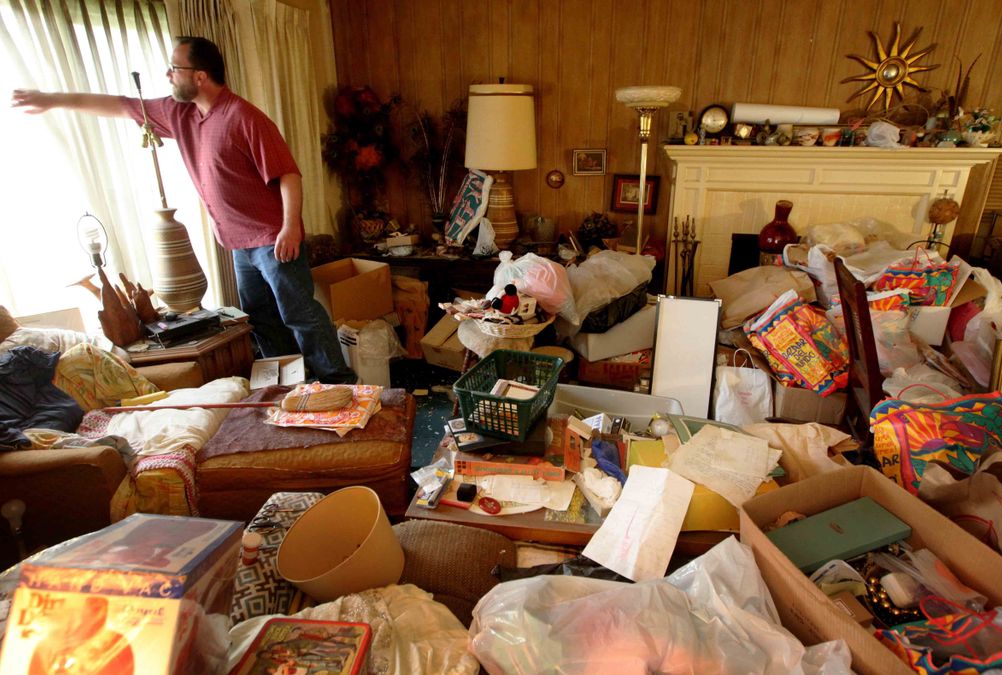
You may solely find out about compulsive hoarding from a distance: a newspaper article a few household residing in squalor with dozens of animals, or a TV present about folks whose properties are filled with junk. Or your expertise with hoarding could be all too shut: the member of the family who retains stacks of previous magazines round, or your personal issue eliminating the stuff that’s slowly taking on your own home.
Hoarding is a critical psychological sickness that may drastically have an effect on the standard of life for the hoarder and their relations. Surprisingly, we do not perceive hoarding as a lot as we thought we did. There are not any simple therapies, and psychiatrists solely just lately acknowledged hoarding as a separate illness, not a symptom of one other downside. It is troublesome to say precisely how prevalent hoarding is, however estimates vary from 0.4 % to as excessive as 4 or 5 % [source: Samuels].
To type out the myths and misconceptions about hoarding from the details being uncovered by new analysis, we’ll take an in depth have a look at hoarding, find out how to cope with it, what could be inflicting it and find out how to acknowledge it.
Contents
- Signs of Hoarding
- Myths About Hoarding
- Underlying Causes of Hoarding
- Remedies for Hoarders
Signs of Hoarding
“”
Metropolis constructing inspector Lauren Mosely images the kitchen of a Chicago, Illinois house the place an aged couple was discovered buried alive within the mess. Alex Garcia/Chicago Tribune/MCT by way of Getty Pictures
You may need a messy home, a room that is bought an excessive amount of junk in it or perhaps an attic you have not organized in years. Does that imply you are a hoarder? No. Compulsive hoarding is a psychological well being downside that makes it troublesome for folks to make choices about materials possessions. There are 4 fundamental signs that signify compulsive hoarding.
- An lack of ability to cease buying issues or eliminate issues. Hoarders usually stockpile or purchase gadgets that don’t have any fast use or worth, like clothes when it is on sale regardless that they do not want any and the garments they purchase aren’t even the proper measurement for them. Hoarders’ properties usually are full of garments or different gadgets which might be nonetheless wrapped in plastic or have the shop tags on them, having by no means been used. Hoarders may also maintain on to issues that do not have any worth in any respect, like stacks of previous newspapers, commercials and unsolicited mail. They can not cease themselves from getting extra junk, they usually cannot drive themselves to eliminate the junk they have already got. Even enthusiastic about throwing one thing away causes them extreme anxiousness.
- The junk is totally disorganized. An individual who stockpiles gadgets however retains them sorted and stacked on cabinets is probably just a little odd, however does not match the outline of a compulsive hoarder. A hoarder’s lack of ability to make choices about what to maintain and what to eliminate extends to creating decisions about sorting and organizing. Because of this, the junk types in piles and stacks that sprawls uncontrolled. The hoarder may keep in mind the place sure gadgets are, however there isn’t any group to the mess.
- The hoarder feels ashamed. This is a vital symptom of psychological sickness. Hoarders compulsively collect junk, then really feel responsible and ashamed of their hoarding, which might result in extra hoarding to attempt to ease the psychological anguish they’re feeling. It isn’t in contrast to an alcoholic whose consuming causes issues of their life, which in flip triggers them to drink extra to keep away from the ache they’ve created. This symptom additionally differentiates hoarders from collectors, even these with monumental collections of seemingly unusual gadgets (sure, even your uncle’s beer can assortment). Collectors are happy with what they’ve amassed, they usually manage and show their issues. Hoarders are by no means happy with the junk of their properties [source: Hale].
- The junk considerably impacts the hoarder’s high quality of life. This will take a number of types. The junk fills in areas of the home till they’re not usable for his or her unique capabilities. Examples embody bathtubs full of stacks of paper, kitchen stoves piled excessive with damaged home equipment or total rooms utterly blocked off. Hoarders will carve small paths via rooms out of necessity, however the piles of junk stop a lot of the home from getting used. It might probably even grow to be a critical well being and security downside.
Hoarders have really died from being crushed by their stuff. Hoarding additionally impacts the hoarder’s social life. They notice they cannot deliver mates into their properties, they usually could also be reluctant to go away their properties due to anxiousness that somebody will rearrange or throw away their possessions whereas they’re gone. Hoarding may also influence funds in quite a lot of methods (as an illustration, the hoarder can solely eat costly takeout meals as a result of they will not use the kitchen to prepare dinner meals). Different private relationships, together with the hoarder’s marriage, can be strongly affected by the dysfunction [source: Arkowitz and Lilienfeld].
You may suppose you already know rather a lot about hoarding, however our enthusiastic about compulsive hoarding has modified rather a lot in the previous couple of years. Let us take a look at a number of the myths about hoarding.
Hoarding Animals
Animal hoarding is similar to different varieties of hoarding, however the hoarder acquires and retains animals as an alternative of junk (in some instances, each animals and junk are hoarded). They really feel the identical lack of ability to eliminate animals that different hoarders really feel with stacks of newspapers. Animal hoarders cannot correctly feed, clear or look after all of the animals they find yourself with, however are unable to acknowledge the hurt they’re inflicting to the animals.
Myths About Hoarding
“”
The extra we find out about hoarding dysfunction, the extra we notice there’s nonetheless a lot to study concerning the illness. Marcus Hessenberg/BarcroftImages/Barcroft Media by way of Getty Pictures
As we study extra about compulsive hoarding, we’re discovering out a few of what we thought we knew is not true. Listed here are some frequent myths about hoarding.
- Hoarding solely impacts older folks. Research have discovered that hoarding signs start exhibiting up as early as adolescence [source: Ayers]. It is a progressive illness that grows worse over time, and solely probably the most extreme instances are inclined to get publicized, so the hoarders we most frequently encounter are older. Recognizing the indicators earlier in life might stop them from getting uncontrolled.
- Hoarders are simply lazy. Hoarding is a critical psychological sickness that drives folks to illogical extremes of acquisition and conserving gadgets. It is not a easy matter of being too lazy to wash up.
- Hoarding is a current phenomenon. Though TV exhibits have introduced hoarding into the general public eye and given it a a lot increased profile within the final 10 years or so, there are historic reviews of hoarding going again centuries. "Dante’s Inferno" describes a circle of hell only for hoarders, whereas the protagonist of the George Eliot novel "Silas Marner," printed in 1861, is in some ways a hoarder, together with the character Plyushkin within the 1842 novel "Useless Souls" by Nikolai Gogol. Sigmund Freud and different early twentieth century psychologists mentioned hoarding behaviors (though they had been manner off the mark after they tried to clarify it) [sources: Arkowitz and Lilienfeld, Herring].
- Hoarders have skilled poverty or deprivation of their previous. One of many methods folks have tried to clarify hoarding conduct is suggesting that it is a response to a interval of poverty or lack of fabric issues of their previous, akin to residing via the Nice Melancholy. Analysis has discovered that no such connection exists [source: Frost and Gross]. Nevertheless, there’s a connection between hoarding behaviors and previous trauma, akin to extreme self-discipline as a toddler. This means that compulsive hoarding could also be a type of post-traumatic stress dysfunction [source: Samuels].
- Hoarding is only a symptom of obsessive-compulsive dysfunction (OCD). Though the seemingly illogical conduct of compulsive hoarding may look much like a number of the behaviors related to individuals who undergo from OCD, current research have discovered that it’s a distinct illness, not merely a symptom of one other illness. For example, hoarders do not expertise the "intrusive ideas" that plague OCD victims. Nevertheless, the problem is difficult by the truth that hoarders usually have OCD, in addition to different psychological well being issues akin to anxiousness and melancholy [source: Duenwald].
- Hoarding will be cured just by simply throwing away all of the junk and cleansing the home. There are occasions when, for well being, security and even authorized causes, an emergency cleanout of a hoarder’s house could be unavoidable. A cleanout won’t change the underlying psychological well being downside, nonetheless. We requested Lisa Hale, founding director of the Kansas Metropolis Middle for Anxiousness Therapy and an adjunct affiliate professor on the College of Missouri-Kansas Metropolis about methods to cope with a member of the family’s hoarding. "A cleanout or transfer to a brand new surroundings doesn’t resolve the conduct with out remedy," she says in an electronic mail. "The statistics actually strategy the one hundred pc mark of hoarding reoccurring except remedy and/or shut environmental oversight is in place."
Underlying Causes of Hoarding
“”
What compels somebody to hoard trash, garments, toys, even their excrement, remains to be being studied. John Robertson/Barcroft Media/Barcoft Media by way of Getty Pictures
There’s nonetheless rather a lot we do not find out about compulsive hoarding, together with what causes it. Hoarding’s classification as its personal illness is a comparatively current occasion — it was first labeled a separate illness in 2013 within the fifth version of the "Diagnostic and Statistical Handbook of Psychological Issues," the information utilized by medical and psychiatric professionals (and insurance coverage firms) to diagnose psychological well being issues. This classification might entice analysis funding and likewise assist compulsive hoarders get remedy lined by their medical health insurance.
"As analysis developed we discovered many traits of hoarding behaviors that instructed it was actually a separate situation, each within the presentation of signs and poor response to therapies recognized to work effectively for OCD," Hale says. "The present line of pondering from the analysis is that hoarding is a neuropsychiatric situation linked to processing challenges — hassle with the connections and performance of emotional, visible, and organizational areas of the mind."
Every research into hoarding offers us one other clue as to the underlying trigger. Hoarding most likely has a genetic element, since analysis has discovered that hoarding conduct is a part of different sicknesses which might be undoubtedly recognized to be genetic, and compulsive hoarders are prone to have relations who’re additionally compulsive hoarders [source: Gothelf]. There are even correlations between hoarding and sure chromosome defects [source: Samuels]. One other research discovered {that a} sure kind of mind lesion appeared to account for the onset of compulsive hoarding in some topics [source: Anderson].
Hoarding appears to be the results of some sort of quick circuit of a traditional human conduct. All of us connect worth and that means to materials gadgets and derive a way of safety from them. Compulsive hoarding is that this similar conduct gone utterly uncontrolled. There’s an evolutionary purpose that we have a tendency to amass issues and need to preserve them, which will be expressed mathematically (the price of buying the gadgets weighed towards the price of not buying them).
The non-math model is that this: Think about that an animal can both save sufficient meals to final via a brief winter or sufficient to final via an extended winter. Gathering the additional meals for an extended winter carries further danger, so quick winter animals have a better probability of surviving. Nevertheless, finally there will probably be an extended winter, which can kill off all of the animals who solely had sufficient meals for a brief winter. The "save up for an extended winter" evolutionary trait, subsequently, will probably be handed on to future generations [source: Bergstrom].
There are extra difficult variations of the state of affairs (akin to a genetic trait that causes lengthy or quick winter methods to happen randomly in the identical animal from yr to yr), however the backside line is that long-term acquisition and saving methods are inclined to have better evolutionary success, and people have acquired that trait from numerous generations of our mammalian ancestors. In some people, the trait goes haywire.
Homer and Langley Collyer: The Most Well-known Hoarders
They by no means bought their very own episode of a TV present, however Langley and Homer Collyer, whose mansion in Harlem was packed flooring to ceiling with junk, turned macabre New York Metropolis sensations after they died in 1947. Older brother Homer was blind, and Langley did little however look after him and gather junk from 1933 to 1947. Homer hadn’t left the home in additional than a decade when he starved to demise after Langley was killed by a junk collapse. In the meantime, crews eliminated greater than 100 tons (90 metric tons) of junk from the home. Weeks into eradicating particles and after discovering Homer, a employee uncovered Langley’s decomposing corpse. Compulsive hoarding was really known as Collyer Syndrome for many years afterward [sources: New York Daily News, Pittsburgh Press].
Remedies for Hoarders
“”
Psychotherapy, or discuss remedy, is a major type of remedy for hoarding. Jim Wilkes/Toronto Star by way of Getty Pictures
There is not a easy, efficient remedy for compulsive hoarding. There are not any medication that particularly goal and scale back hoarding behaviors. Nevertheless, hoarding usually seems alongside different psychological well being issues like melancholy, anxiousness or OCD, and treating these sicknesses with drugs will be a technique to assist handle hoarding [source: Hale].
Successfully preventing compulsive hoarding requires a staff effort that features the hoarder and their household. Psychotherapy, or discuss remedy, is a major type of remedy for hoarding. One of the best course of discuss remedy remedy is named cognitive behavioral remedy (CBT). It really works to change the cycles of thought and conduct which might be inflicting the hoarder to have issues. The CBT must be tailored particularly for hoarding, and the remedy course can take from six months to a yr. Medicines can be added, significantly if the hoarder additionally has anxiousness or melancholy.
"With a view to assist management the skilled prices of remedy, and higher promote improvement of the varieties of environmental helps that may sustain expertise use after the lively remedy stage, we embody behavioral household remedy/teaching and likewise usually contain an expert organizer who’s accustomed to hoarding," Hale says.
One component of the remedy includes the hoarder studying to establish and problem his ideas about shopping for and saving issues, in addition to training eliminating them. This will transfer on to studying find out how to manage issues, and getting assistance on deciding which issues to eliminate earlier than, hopefully progressing to efficiently clearing out and utterly decluttering giant quantities of the hoard.
Specializing in the advantages clearing out the hoard will hopefully change the hoarder’s thought patterns, decision-making and coping expertise. For instance, as an alternative of worrying about needing a stockpile of clothes sometime and what may occur if they do not have the clothes, hoarders can as an alternative give attention to utilizing the cleared room to develop vegetation or invite mates over to play playing cards. Breaking down these limitations can scale back their isolation and improve social involvement.
Even with a full course of remedy, compulsive hoarding tends to reoccur, particularly with out ongoing assist from relations and through instances of stress. It is a troublesome and insidious psychological well being downside to deal with, so sustaining ongoing remedy is important.
Authorized Issues and Hoarding
Neighbors could discover a hoarder’s property a nuisance as a result of it attracts rats or is unpleasant. In extreme instances, a municipality can declare the property unsafe and order particular cures that should be made, however it’s usually troublesome to legally drive a hoarder to vary their methods. Hoarders do not grow to be mentally incapacitated by their sickness, so relations cannot get energy of legal professional or drive them into remedy, and if the hoarding does not attain the purpose of violating the legislation, there’s not a lot that may be performed. Many cities have shaped process forces particularly designed to cope with hoarding instances to assist type via the difficult authorized points.






















